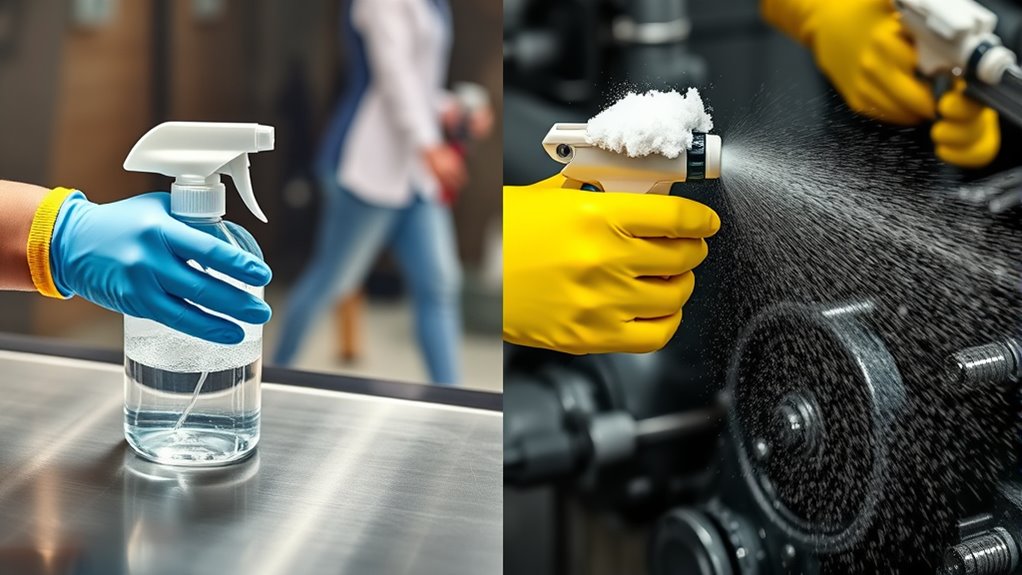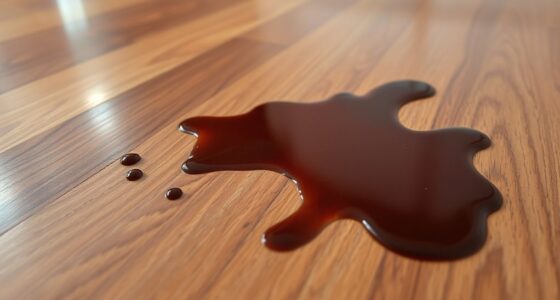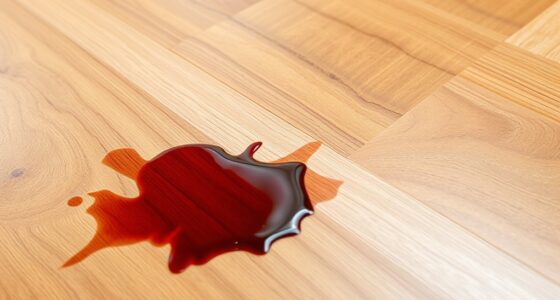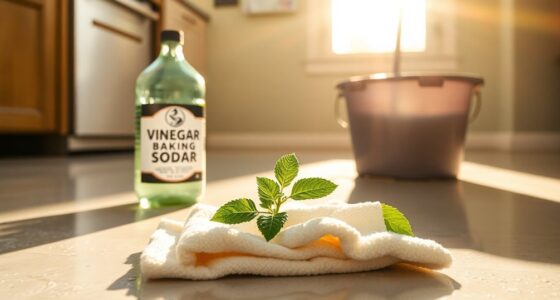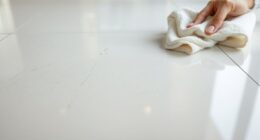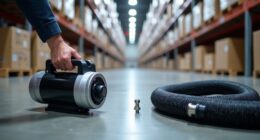To use neutral cleaners, apply them for routine cleaning on surfaces like glass, plastics, or painted areas, following the manufacturer’s instructions and testing in a small spot first. Degreasers are best for heavy grease or oily residues; use them sparingly and verify you wear protective gear. Always match the product to the dirt type and surface compatibility. If you want to learn more about proper application techniques and safety tips, keep exploring the details.
Key Takeaways
- Use neutral cleaners for routine cleaning of delicate surfaces and light dirt, following manufacturer instructions.
- Apply degreasers for heavy grease, oil, and stubborn residues, ensuring compatibility with the surface.
- Always test on a small, inconspicuous area before full application to prevent damage.
- Follow recommended dilution and contact time for both neutral cleaners and degreasers.
- Wear protective gear when handling degreasers and ensure proper rinsing to avoid surface damage.

Choosing the right cleaning product can make a significant difference in maintaining a safe and effective workspace. When deciding between neutral cleaners and degreasers, it’s essential to understand their purpose and how they interact with different surfaces. Neutral cleaners typically have a pH level close to 7, meaning they are neither acidic nor alkaline. This balanced pH helps guarantee surface compatibility, making them safe for a wide range of materials without causing damage or corrosion. If you’re cleaning delicate surfaces like glass, plastics, or painted finishes, neutral cleaners are usually the best choice because they clean effectively without risking deterioration.
Neutral cleaners with a pH near 7 are ideal for delicate surfaces, ensuring effective cleaning without damage.
On the other hand, degreasers are formulated specifically to tackle heavy grease, oil, and stubborn residues. They are often more alkaline, with a higher pH level, which makes them powerful against oily build-up. However, this strength comes with a caution: not all surfaces are compatible with aggressive cleaning agents. You need to take into account surface compatibility when choosing a degreaser. For instance, using a strong degreaser on a sensitive plastic or a painted surface might cause discoloration or degradation. To avoid damage, always check the product label for recommended surfaces and test on a small inconspicuous area first.
Understanding pH balance is vital. Neutral cleaners, with their balanced pH, are gentle yet effective for routine cleaning, maintaining the integrity of most surfaces. Degreasers, being more alkaline, are best suited for industrial or heavily soiled areas where grease and oil accumulation are significant. They break down stubborn residues more efficiently but require careful use to prevent harm to surfaces that are not compatible. Additionally, the pH level of a cleaning product can influence its cleaning strength and safety, making it an important factor in your selection process.
When selecting between the two, consider the type of dirt you’re dealing with. Light dust, dirt, or everyday spills are best handled with neutral cleaners that won’t risk damaging the surface. For tougher, greasy messes, a degreaser can save you time and effort, but only if it’s appropriate for the surface you’re cleaning. Always follow the manufacturer’s instructions regarding dilution and contact time, and wear protective gear if necessary. Properly matching the cleaning product to the surface and soil type guarantees a thorough clean without unintended damage, helping you maintain a safe, clean, and long-lasting workspace.
Frequently Asked Questions
Can Neutral Cleaners Remove Heavy Grease Buildup Effectively?
Neutral cleaners can remove light to moderate grease but aren’t very effective against heavy grease buildup. For heavy grease, you need a stronger degreaser, as neutral cleaners may not break down stubborn, thick layers. Always prioritize surface safety; test in a small area first to ensure the cleaner won’t damage the surface. Use the appropriate product for the job to achieve the best results without risking damage.
Are Neutral Cleaners Safe for All Types of Surfaces?
Neutral cleaners are generally safe for most surfaces because of their balanced pH, which minimizes damage. However, you should always check surface compatibility first, especially with delicate or porous materials. Test a small area before full application to verify it won’t cause discoloration or harm. When used properly, neutral cleaners provide effective cleaning without risking surface damage, making them a versatile choice for many cleaning tasks.
How Should I Dilute Degreasers for Different Cleaning Tasks?
You should follow the concentration guidelines on the degreaser label for different cleaning tasks. Usually, for heavy grease, use a stronger mix, like 1:1, and for light dirt, dilute it more, such as 1:10. Apply the degreaser using appropriate techniques, like spraying or wiping, ensuring even coverage. Always test on a small area first to prevent damage, and adjust dilution based on the surface and dirt level.
Do Neutral Cleaners Leave Any Harmful Residues?
Like a gentle rain that leaves no trace, neutral cleaners typically don’t leave harmful residues behind. You can trust them for residue safety and lower environmental impact, making them a safe choice for many cleaning tasks. They’re designed to rinse clean and be less aggressive, ensuring they won’t compromise your surfaces or the environment. So, after cleaning, you won’t have to worry about leftover residues affecting safety or sustainability.
When Is It Necessary to Use a Degreaser Instead of a Neutral Cleaner?
You need to use a degreaser instead of a neutral cleaner when tackling heavy, industrial strength grease or oil buildup, especially on tough surfaces. Degreasers are designed to cut through stubborn grime without damaging delicate surfaces. If your cleaning task involves stubborn grease or thick residues, opt for a degreaser. For lighter cleaning needs, neutral cleaners are safer and sufficient, but for industrial strength cleaning, degreasers are your best choice.
Conclusion
Choosing between neutral cleaners and degreasers is like selecting the right brush for your canvas—you need the right tool to bring out the best. I once watched my friend struggle with a stubborn grease stain, only to realize a degreaser was the key to success. Just as a painter knows their brushes, understanding when to use each cleaner guarantees your surfaces shine. With the right choice, you’ll turn cleaning into a satisfying masterpiece every time.
